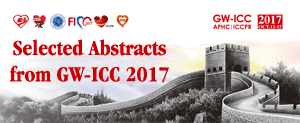[GW28-e0486]
3D Echocardiographic evaluation of the association between pulmonary hypertension and right ventricle function in patients with severe rheumatic mitral stenosis
Jingjing Liu Lingyun Fang
Department of Ultrasound, Union Hospital, Tongji Medical College, Huazhong University of Science and Technology, Wuhan
Objectives: Post-capillary Pulmonary hypertension (PH) is asignificant contributor to right ventricle (RV) dysfunction and morbidity. The two hemodynamic profiles in left heart disease with PH, passive PH with increased pulmonary venous pressure and reactive PH with increased pulmonary vascular resistance (PVR>3 Wood units, WU), are difficult to distinguish non-invasively. The clinical significance of PVR on right ventricle function remains to be elucidated in patients with rheumatic mitral valve stenosis (RMS).
Methods: Between 2014-2016 thirty-nine patients referred to our hospital for the management of pure severe RMS (mitral valve area≤1.5 cm2, stage D) were included in this study. Two groups were formed based on PVR (calculated based on the ratio of TRV/TVIRVOT), 18 patients have PVR≤3 WU (group II), and 21 patients have PVR>3 WU (group III). Twenty age-matched healthy subjects with normal echocardiograms served as controls (group I). RV function was assessed using 3D echocardiography according to the recommendations of the American Society of Echocardiography. 3D longitudinal global strain of the RV freewall (RV GLS-freewall) and interventricular septum (RV GLS-septum) were measured using commercially available hardware and software (Philip IE33, Tomtec 4D-RV-analysis software).
Results: All indices of RV function were significantly lower in patients with reactive PH (Group III) including RV EF, FAC (fractional area change), TAPSE (Tricuspid annular plane systolic excursion, mm) and increase in Tei index (myocardial performance index) compared to group I and II. Patient with passive PH (Group II) have moderate reduced EF and elevation in Tei index as compared to normal controls (Group I). There are no significant difference in FAC and TAPSE between group I and II. RV GLS-freewall and GLS-septum were significant lower in group II compared to group I (p<0.01). Group III patients had further decrease in RV GLSfreewall and GLS-septum compared to group I or II (p1<0.01, p2<0.05, respectively). Multiple linear regression analysis revealed a significantly correlations between GLS (freewall) systolic strain and PVR (r=0.825,p <0.001), as well as between GLS(septum) systolic strain and PVR (r=0.756, p<0.001).
Conclusions: Incremental impairments of RV dysfunction were observed in severe rheumatic MS patients from passive to reactive PH. Our study identified a significant correction between global RV longitudinal systolic strain and PVR, suggesting that RVGLS may serve as good index for assessing PH subtypes and RV dysfunction.














